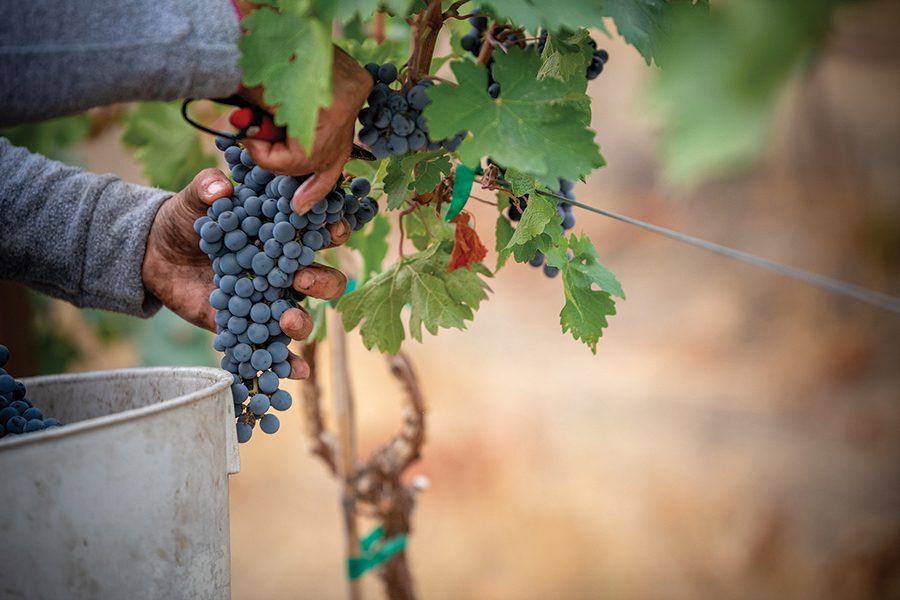
Home » Wine grape quality continues to shine despite setbacks
Red’s reign
Wine grape quality continues to shine despite setbacks

June 14, 2024
The wine grape harvest in Washington was small in 2023.
A total of 159,000 tons of grapes were harvested in vineyards across the state last year – a drop of 34% over 2022, according to data from the Washington State Wine Commission.
The drop largely was due to forces in the local and national wine market, said Kristina Kelley, commission executive director. But there was no drop in quality, she said.
“The 2023 vintage was terrific from a quality standpoint,” she said. “It was a small crop, but there will still be plenty of top-notch Washington wines coming out of the vintage.”
And “we think there will be some upside as we look out over the next several years, where we hope to reset our market to gravitate towards more of the premium wines,” Kelley said.
By the numbers
The commission published its annual grape production report in late April 2024, using data provided by wineries and growers across Washington.
Once again, cabernet sauvignon was the top grape variety in 2023 by a significant margin, with 48,369 tons, or 30% of the total grapes produced in the state. Riesling moved up to second place, bumping out chardonnay, with 24,357 tons, or 15% of the total.
Chardonnay was in the No. 3 spot with 22,149 tons.
Other top varieties included syrah, merlot, sauvignon blanc and pinot gris.
The state’s red varieties accounted for 59% of total production, up from 57% in 2022. Growers received an average of $1,542 per ton in 2023, up $172 over the year before.
Cabernet franc saw the highest average price per ton at $2,254.
The 2023 growing season ended up being extended by moderate temperatures in September and October, according to information from the wine commission.
The season started out cool, then warmed up more than usual in May.
“June was marked with hot temperatures in the Columbia Valley, but July steadied out with temperatures that were still above average but not hot enough to shut down the vines,” the commission said in a statement. The fall weather allowed winegrowers and winemakers to pick at their own pace, and “that extended hang time really allowed the flavors to develop nicely, with good acid and balance throughout,” Kelley said in the statement.
Looking ahead
The commission attributed a decline in the overall wine market to factors ranging from the economy to changing consumer behavior. The state’s wine industry also took a hit last year when Ste. Michelle Wine Estates – the Northwest wine giant – announced that it would be dramatically cutting its grape contracts over the next five years.
At the same time, Washington grape growers may be picking up a new opportunity. Washington’s wine industry is looking into sending grapes to Canada after British Columbia growers were hard hit by freezing weather.
Rianne Ham, manager of the international marketing program for the Washington State Department of Agriculture, said her agency has been working with the wine commission and Washington Winegrowers Association to help clarify export regulations.
A trade mission to Vancouver and Ottawa with the Association of Washington Business and lieutenant governor’s office also was planned in June, with grapes on the agenda, she said. “It might not be a long-standing opportunity, but it might be a couple of years while we can get our production more balanced,” Ham said.
Sustainability focus
Kelley pointed to other reasons to celebrate in the last year.
“We’re seeing our first wines – red wines – that have been certified as sustainable through Sustainable WA,” she said, referring to the certified sustainability program for wine grapes that launched in 2022 via the wine commission and other state wine industry groups.
Sustainable WA also recently joined with Salmon-Safe, which works to protect water quality, maintain watershed health and restore habitat, in a new certification partnership. Vineyards in the program can now obtain dual certification.
The state’s wine industry also is seeing growth, namely in direct-to-consumer business and premium wines. “As we look at the data, what we’re really seeing is growth in our industry at the $15 to $25 price point range. It continues to be a significant bright spot for Washington. Over this past year, at that price point, we’ve seen a 48% growth in volume share in that price range, which tells me that there is such an appetite for Washington wine at that little bit of a higher price point,” Kelley said.
Positioned for growth
In fact, overall, “(the state’s wine industry) is well positioned to continue to grow. As we look at the great quality, the different price points, we really feel that there is an opportunity for Washington wine. Even though we had a bit of a setback in 2023, we’re underway to be able to make up for some of that loss in production,” she said.
Washington wines offer quality at all price points, she said.
“Whether you’re a novice or you’re somebody who has been involved in wine for a long time, we really do have something for everyone,” Kelley said.
Focus Magazine Agriculture + Viticulture
KEYWORDS June 2024
Related Articles





